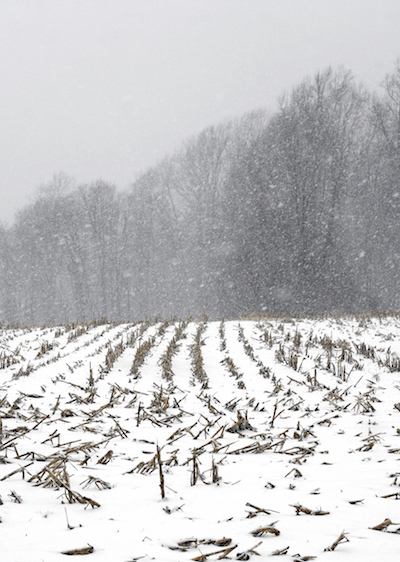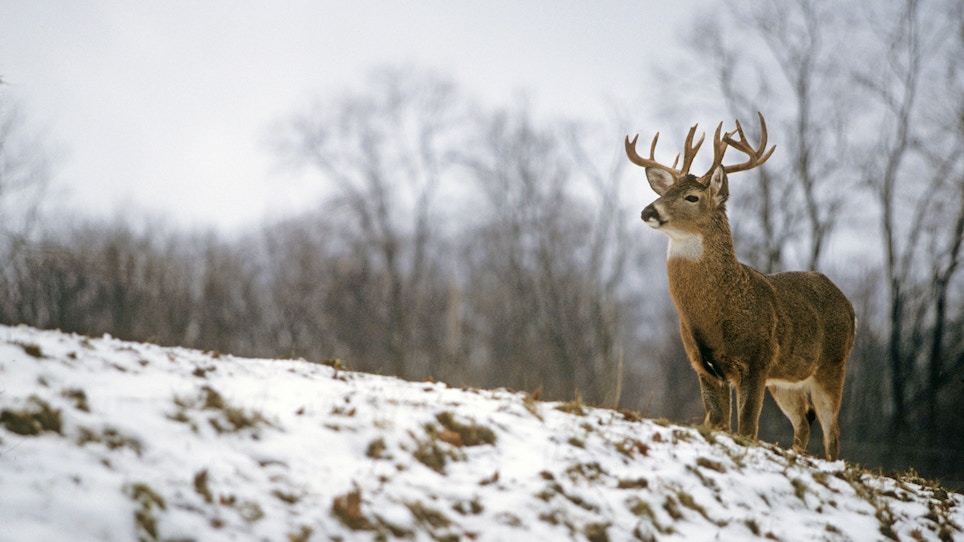The next time you find yourself scheduling vacation for deer hunting, consider flipping past Halloween and Thanksgiving and poring over the possibilities around December 10.Why? Well, it’s not because of the so-called “second rut.” Yes, rut activity sometimes occurs in early December, but it’s minor.
The bigger factors are:
- Hunger
- Food availability
- Cold weather
- Little or no hunting pressure.
When those factors combine before mid-December — and you throw in random late-breeding activity for added spice — you’ll often see deer activity that outshines the main rut of late October through mid-November.
True, breeding activity can tick upward in early December as doe fawns enter heat for the first time and an occasional doe recycles after failing to get pregnant four weeks earlier. But the second rut is more a last gasp than a second wind, and breeding in December north of the Mason-Dixon line results more from convenience and coincidence than relentless pursuit.
Related: What do deer eat in winter?
December's "perfect storm" for deer hunters
Although there’s no guarantee the early to mid-December time frame will produce great deer activity each year, the ingredients for a deer hunter’s “perfect storm” almost always swirl about that time. Those ingredients include:

Large agricultural fields often offer the most abundant and accessible foods, and hunger drives deer to make daylight appearances. Photo: iStock
Food sources compress and food varieties dwindle.
In Northern regions, most crops have been harvested by then, and many acorns and nutritious leaves have been eaten or buried under early snowfalls. Deer congregate on remaining foods and deplete them further.
The whitetail’s metabolism hasn’t yet slowed for winter, which means hunger can be relentless.
They must find food to maintain their energy reserves, and when they find it, they’ll stay longer to eat.
Cold temps
Snow, wind and cold temperatures cause whitetails to burn more calories, further increasing their need for nutritious, energy-rich foods.
Bucks are never hungrier.
Besides the increased energy demands that all whitetails face, bucks are trying to recover from the rut, when they lose as much as 25 to 30 percent of their weight. But no matter how much they eat, they won’t add fat. All they can do is regain energy and stamina.
Hunger drives daylight cameo appearances.
Large agricultural fields often offer the most abundant and accessible foods, and hunger drives deer to make daylight appearances. It’s often possible to monitor feeding activities and find possible setups by driving backroads.
The pressure eases up.
Hunting pressure tails off by late November, making deer feel more secure when moving at dawn and twilight in the weeks that follow.
The second rut.
Although it seldom pays to bank on the second rut, late-breaking breeding action sometimes creates opportunities. After all, when female deer congregate on fields of snow-dusted alfalfa, they create a target-rich environment. If a buck encounters an estrous doe while eating, he might have just enough sex drive remaining to pursue her when she first rebuffs his advances. If the doe continues being evasive, her route might drag the buck within range of your bow or gun.
“Perfect Storms” Aren’t Guaranteed
Even so, those seven factors don’t create a “perfect storm” each December on schedule. If you’re cursed with a heat wave, extended rain or a gradual cooling trend that eases deer into winter, early December can prolong your post-rut blues.
But if you’re lucky, snow will arrive in late November or early December, making it easier to scout for feeding areas. Also, hope for temperatures to plunge into the single digits or below zero. Early wicked cold snaps can shock deer into binge eating.
Related: Why hunters aren't prepared for the cold
If you find good acorn caches, or fields of soybeans, corn or brassicas, dress for nose-numbing temperatures and get out there. The same goes for alfalfa or other nutritious plants that remain upright, their leaves and stems accessible beneath light snow. Deer will hit these fields if the food is accessible. Setting up along field edges can pay off, especially for late-afternoon hunts. Just make sure you’re upwind or crosswind to the deer’s approach routes and feeding areas.
When you get unseasonable warmth and rain instead of cold and snow, realize that few mature deer will appear on feeding grounds until last light. Field edges can waste your time under such conditions, so get as close as you dare to bedding areas. Your hope is to see them start their feeding run in daylight.
If scouting reveals deer still on their feeding grounds after dawn, study the terrain between their feeding and bedding areas. Try to sneak in and intercept them on their return routes. If you can’t avoid spooking them off fields or acorn flats as you approach before dawn, stay in bed. But if you can find a backdoor entrance, take that long hike and drop into an ambush site near their bedroom.
Related: How to hunt in cold weather
Featured photo: John Hafner






